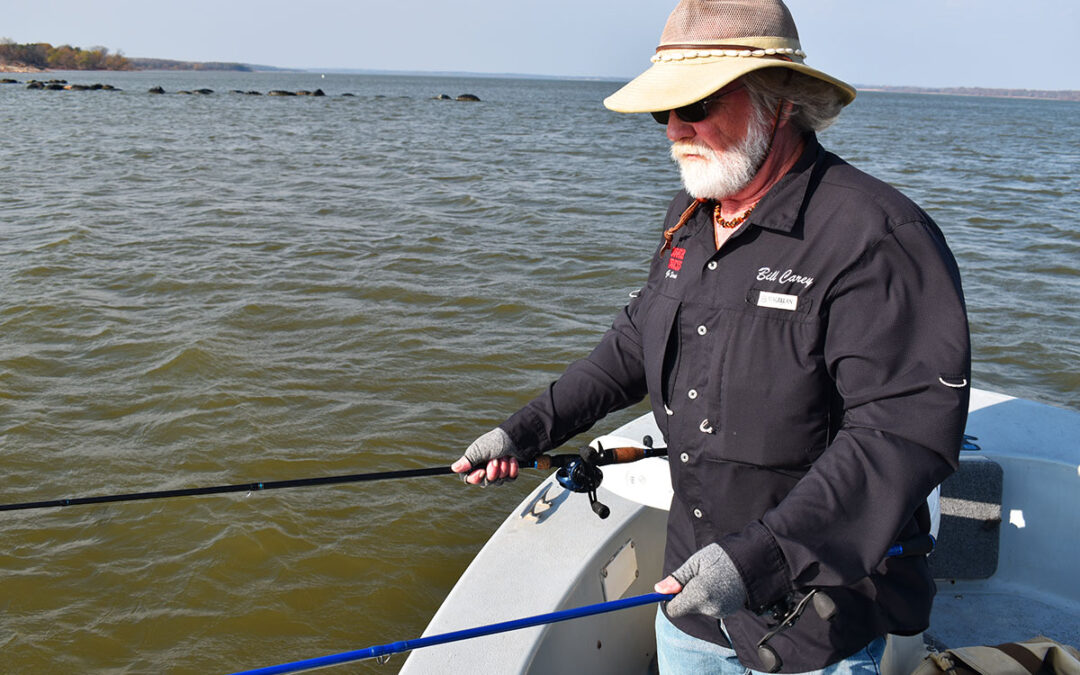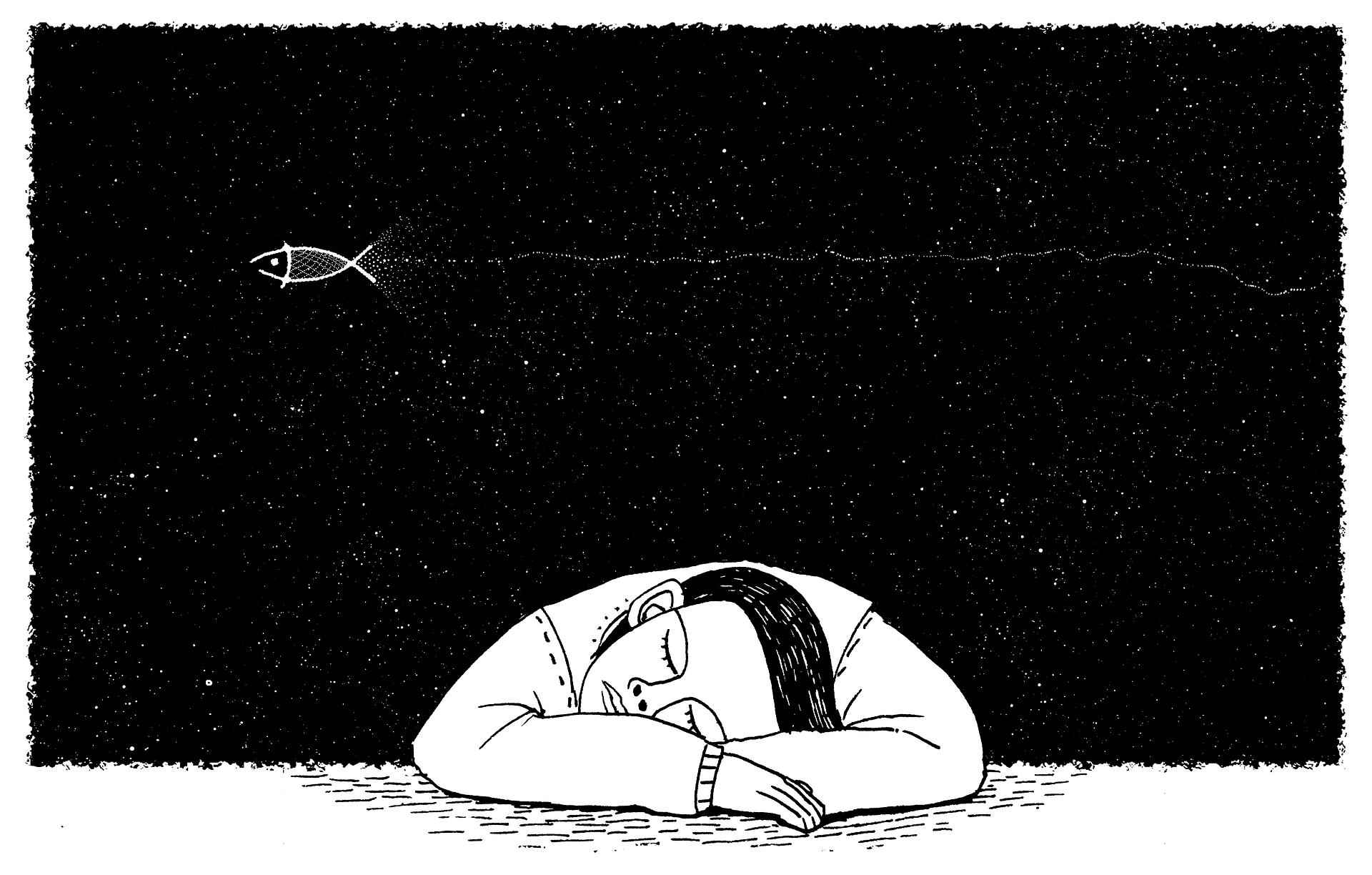DEADSTICKING – MORE ACTION THAN THE NAME IMPLIES
The only thing the fishing technique known as “deadsticking” has to do with the word “dead” is the lack of activity by the fisherman before the hookset, especially when dealing with those hard fighting stripers while fishing Lake Texoma, situated on the Texas/Oklahoma border.
This past week my grandson, Luke Zimmerman, and friend, Jeff Rice, joined guides, Bill Carey, and is son, Chris, for a day of winter striper fishing Lake Texoma. Chris has been guiding since he was 19 and his dad, Bill, opened the doors to their family business four decades ago. These days, Bill keeps busy managing the guide service but still finds time to slip out to fish on occasion. Chris is one of the premier guides on the lake and has a reputation of not following the crowd. He knows the lake well and all the hotspots and seasonal patterns. He’s quick to point out that deadsticking it is a very deadly method of catching stripers when the water temperature drops in the dead of winter and fishing on the main lake gets tough. Before our trip, he agreed to get back in a creek channel in a secluded cove to demonstrate the technique, predicting we would catch a few fish, but we would also spend some time fishing the more open water pattern.
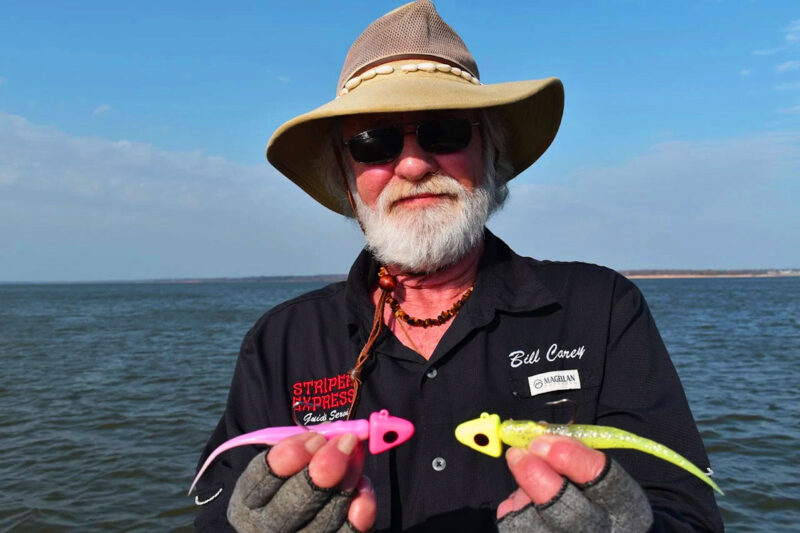
Bill Carey showing a couple jigs rigged for deadsticking.
Deadsticking is often referred to as a “do nothing” style of fishing, but I beg to differ. Properly executed, this technique requires the angler’s full attention. I first learned about deadsticking a couple decades ago on a very cold winter’s day and have used the technique only a handful of times, always with an experienced guide. Good sonar is a must in finding creek bends and submerged points holding stripers. Once fish are located holding near structure, Spot-Lock is employed and the trolling motor keeps the boat in perfect position. One ounce jig heads with four- or five-inch soft plastics are often used, and the baits are positioned just above the water column holding the majority of stripers. Chartreuse or white glow are top color choices on Lake Texoma.
“Thumpers” are a key to success when deadsticking. So, what’s a Thumper? Well, it’s a proven fact that stripers pick up on the repetitive sound of the thumping of a rubber mallet on the bottom of the boat and draw under the boat for a closer inspection. Don’t ask me why it works, but I can say with certainty that it does. The fish’s sensitive lateral lines pick up on the sound and they are drawn in under the boat as though pulled by a magnet.
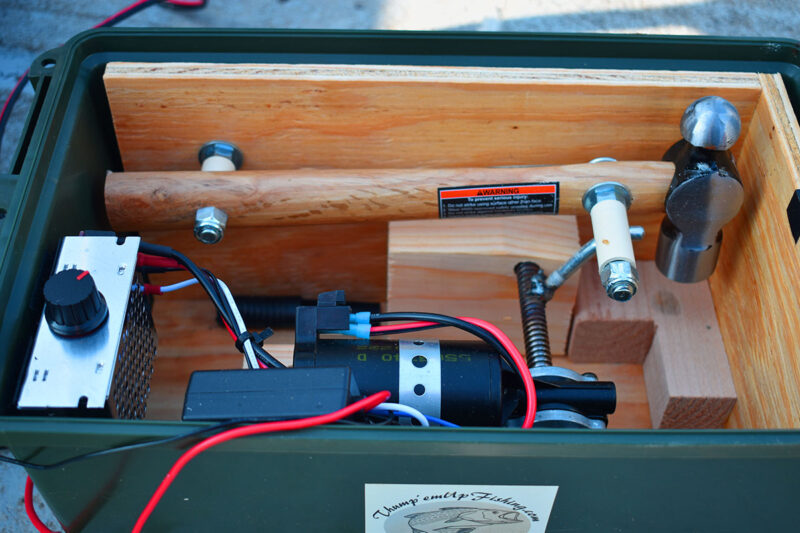
Thumper
Years ago, I remember guides using a walking cane with a soft rubber tip to drum on the floor of the boat. There are several automatic thumpers that work on DC battery power. Once turned on, a lug on a revolving wheel caused a mallet to rise and fall, which transmits the thumping sound down to the stripers below. Once the thumper is turned on, sonar will show more and more stripers pulling up under the boat. During warm weather months when stripers and white bass are chasing baitfish near the surface, churning the water with a fishing rod or using a trolling motor prop half out of the water will often congregate the fish. It’s no secret that schooling species respond to sounds in the water. It stands to reason sounds transmitted through the water is a primary way fish locate their prey.
On or recent trip, after enjoying some great action under flocks of sea gulls and fishing shallow flats close to submerged channels, Chris headed his boat into and inlet which was protected from the steady 20 to 25 mph north wind. I watched his sonar closely as he looked for a spot to employ the deadly deadsticking technique. A secondary channel joined the main creek channel we were checking and at the junction, a scattered school of stripers marked the graph. They were holding at 19 feet.
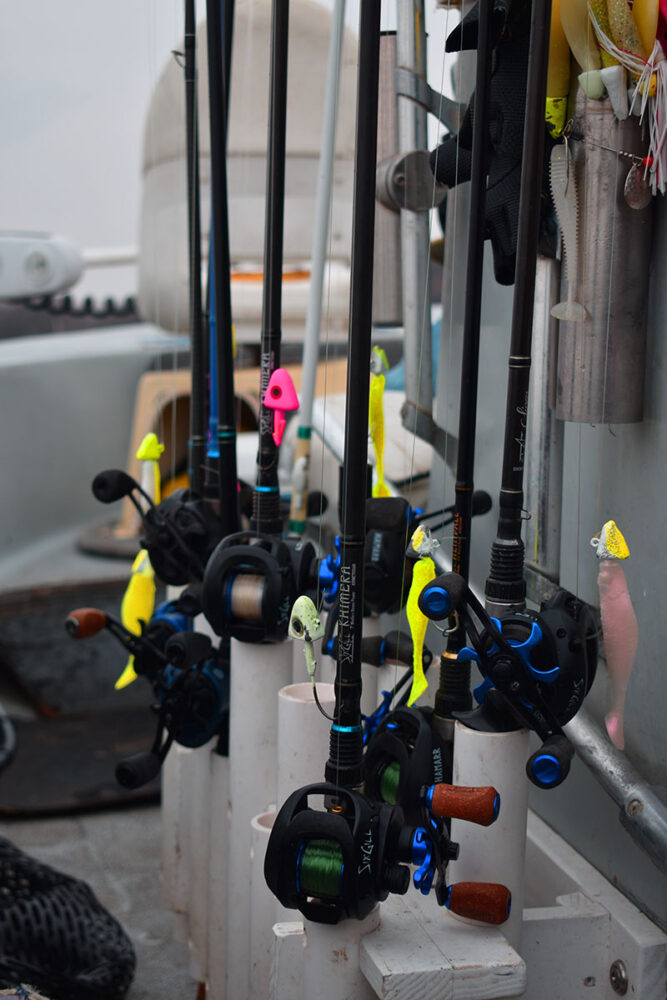
Rods rigged for winter striper!
“The trick is to get the baits down about 18 feet,” Chris said, “or close to that, just above the stripers. The bite won’t be aggressive, so you need to set the hook when you feel the slightest movement of the line or, when you feel slack in the line. It is very common for stripers to take the bait from below, resulting in a slack line.”
This style fishing can better be likened to catching crappie or possibly bream. The stripers are simply sucking the baits in rather than hitting them on the run as when the water is warmer. If you aren’t on your toes, you will miss the tentative bites but, if you set the hook hard when you sense the slightest change in line tension, you will learn that a tentative bite from a big striper can turn instantly to a battle royale when the fish feels the hook!
Once we had the baits down in position, I noticed Bill was fishing with two rods. “The extra bait in the water will help to put the stripers in a biting mode,” says Bill as he intently watched the rod tip of both rods. “But what do you do,” says I, “if you get a strike on both rods?” Bill replied to watch and learn! As the fish continued to pull in under the boat in larger numbers, the bite intensified. Texoma has a liberal limit, 10 stripers under 20 inches and two over 20 inches. We had caught our limit of ‘under’ fish on the main lake but the bigger fish were coming from the sheltered creek channel we were fishing.
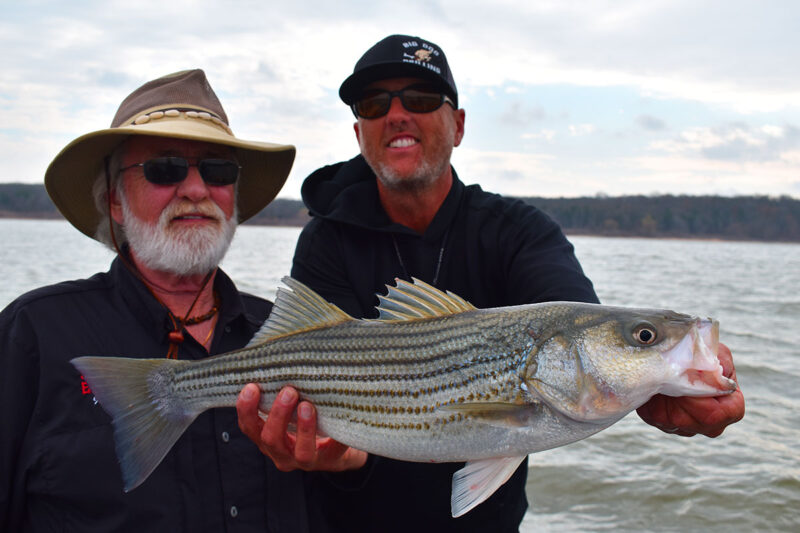
Guides Bill (left) and Chris (right) Carey. Father and son.
Out of the corner of my eye, I noticed Bill jerk up hard on both rods. He had a double on. He summarily set on the butt end of one rod on the gunwale of the boat, landed a 26 inch striper with the other and then proceeded to catch the one on the rod he was setting on! I kidded my buddies that that was a feat for a 40 year veteran guide; we had better continue fishing with a single rod!
As we concluded our fishing trip, Chris mentioned that we were getting in on the very early winter deadsticking. As winter progresses and the water temperature continues to drop the bite will get even better.
***
Lake Texoma is located about 2.5 hours north of Dallas on the Texas/Oklahoma border. Thanks to salt deposits about forty miles above the lake on the Red and Washita Rivers, water’s flowing into Texoma has the ‘just right’ salinity to give buoyancy to the striper eggs. Texas is the only lake in the south/southwest that has a natural occurring striper hatch each year, insuring a bountiful supply of stripers year after year. With a limit of 10 stripers under 20 inches and 2 over 20 inches per angler, Texoma enjoys one of the most liberal limits of any striper lake in the country.
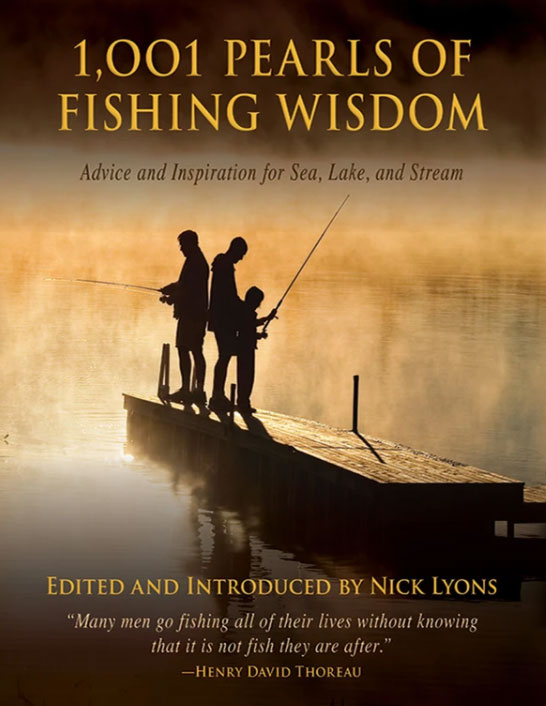 Spanning lighthearted humor to contemplative moments on fly fishing, bass fishing, saltwater fishing, and more from writers like Ernest Hemingway, Ed Zern, Ted Hughes, Cervantes, Thomas McGuane, and scores more, this handsome collection the essence of the sport of angling. It’s the perfect gift for every fisherman.
Spanning lighthearted humor to contemplative moments on fly fishing, bass fishing, saltwater fishing, and more from writers like Ernest Hemingway, Ed Zern, Ted Hughes, Cervantes, Thomas McGuane, and scores more, this handsome collection the essence of the sport of angling. It’s the perfect gift for every fisherman.
For everyone, from those who enjoy fishing as an occasional pastime to those who revel in the philosophies of one’s relationship with the water, rod, and reel, this book of quotable fishermen is the ultimate repository of fishing wisdom. From proverbs to professional tips to general words of insight, this collection of quotes is the go-to guide for anyone who loves some aspect of the wonderful world of fishing. Chapters includes: Some Hints About Why We Fish, Techniques and Strategies, When and Where We Fish, Big Fish, The Lighter Side and much More! Buy Now

